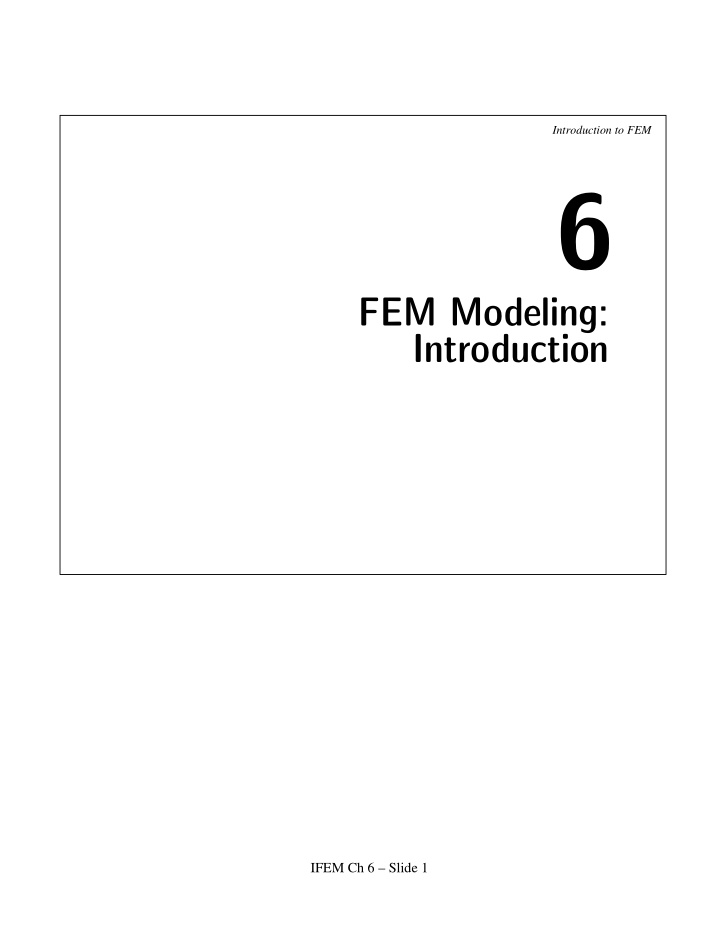



Introduction to FEM 6 FEM Modeling: Introduction IFEM Ch 6 – Slide 1
Introduction to FEM FEM Terminology degrees of freedom (abbrv: DOF) state (primary) variables: displacements in mechanics conjugate variables: forces in mechanics stiffness matrix master stiffness equations K u = f K u = f + f I M IFEM Ch 6 – Slide 2
Introduction to FEM Physical Significance of Vectors u and f in Miscellaneous FEM Applications Application State (DOF) vector u Forcing vector f Problem represents represents Structures and solid mechanics Displacement Mechanical force Heat conduction Temperature Heat flux Acoustic fluid Displacement potential Particle velocity Potential flows Pressure Particle velocity General flows Velocity Fluxes Electrostatics Electric potential Charge density Magnetostatics Magnetic potential Magnetic intensity IFEM Ch 6 – Slide 3
Introduction to FEM Where FEM Fits (from Chapter 1) IDEALIZATION DISCRETIZATION SOLUTION Physical Mathematical FEM Discrete Discrete system model solution model REALIZATION & CONTINUIFICATION Solution error IDENTIFICATION Discretization + solution error Modeling + discretization + solution error IFEM Ch 6 – Slide 4
Introduction to FEM Idealization Process (from Chapter 2) member support joint Physical System IDEALIZATION �� �� �� �� �� �� Mathematical Model IFEM Ch 6 – Slide 5
Introduction to FEM Mathematical Model Definition Traditional definition Scaled fabricated version of a physical system (think of a car or train model) Simulation oriented definition A model is a symbolic device built to simulate and predict aspects of behavior of a system IFEM Ch 6 – Slide 6
Introduction to FEM Implicit Modeling COMPONENT LEVEL Mathematical model Component equations FEM Library of Black-Box FEM Code Component SYSTEM discrete LEVEL model Complete solution System discrete model Physical system IFEM Ch 6 – Slide 7
Introduction to FEM Recall the "Breakdown" DSM Steps Disconnection Breakdown Localization Member (Element) Formation -> generic elements Let Stop Here and Study Generic Elements next IFEM Ch 6 – Slide 8
Introduction to FEM ... Because Most of the Remaining DSM Steps Globalization Merge Application of BCs Solution Recovery of Node Forces are Element Independent IFEM Ch 6 – Slide 9
Introduction to FEM Attributes of Mechanical Finite Elements Dimensionality Nodes serve two purposes: geometric definition home for DOFs (connectors) Degrees of freedom (DOFs) or "freedoms" Conjugate node forces Material properties Fabrication properties IFEM Ch 6 – Slide 10
Introduction to FEM Element Geometry Is Defined by Node Locations 1D 2D 2D 3D IFEM Ch 6 – Slide 11
Introduction to FEM Classification of Mechanical Finite Elements Primitive Structural Continuum Special Macroelements Superelements Substructures IFEM Ch 6 – Slide 12
Introduction to FEM Primitive Structural Elements (often built from MoM models) Physical Finite Element Mathematical Structural Discretization Model Name Component bar beam tube, pipe spar (web) shear panel (2D version of above) IFEM Ch 6 – Slide 13
Introduction to FEM Continuum Elements Finite element Physical Physical Finite element idealization idealization plates 3D solids IFEM Ch 6 – Slide 14
Introduction to FEM Special Elements Infinity double node Honeycomb Infinite Crack panel element element IFEM Ch 6 – Slide 15
Introduction to FEM MacroElements IFEM Ch 6 – Slide 16
Introduction to FEM Substructures IFEM Ch 6 – Slide 17
Introduction to FEM Substructures (cont'd) S6 S4 S2 S5 S1 S3 IFEM Ch 6 – Slide 18
Introduction to FEM Boundary Conditions (BCs) The most difficult topic for FEM program users ("the devil hides in the boundary") Essential Two types Natural IFEM Ch 6 – Slide 19
Introduction to FEM Boundary Conditions Essential vs. Natural Recipe: 1. If a BC involves one or more DOF in a direct way, it is essential and goes to the Left Hand Side (LHS) of Ku = f 2. Otherwise it is natural and goes to the Right Hand Side (RHS) of Ku = f IFEM Ch 6 – Slide 20
Introduction to FEM Examples of Structural Models: Machine Component (Mech. Engrg) IFEM Ch 6 – Slide 21
Introduction to FEM Examples of Structural Models: Dam under Ground Motion (Civil Engrg) ��� ��� ��� Cavitating volume ��� ��� Water ����� ��� Concrete ��������� ��������� ����� ��� ��� Saturated soil Unsaturated fill ��������� ��������� Sandstone Base rock ��������� Base ground motion IFEM Ch 6 – Slide 22
Introduction to FEM Examples of Structural Models: Rocket Nozzle (Aerospace Engrg) Rotational axis �� GRAPHITE 21.37" �� GLASS FILAMENT GLASS FABRIC �� STEEL SHELL INSULATOR ASBESTOS (a) Typical solid rocket nozzle (b) Finite element idealization (Aerojet Corp., 1963) IFEM Ch 6 – Slide 23
Introduction to FEM Examples of Structural Models: SuperTanker (Marine Engrg) A B Neutral Axis Stringer Web Frame Centerline Girder Longitudinal Cross section of tanker Typical internal structure of tanker IFEM Ch 6 – Slide 24
Introduction to FEM Examples of Structural Models: F16 External View (Aero) IFEM Ch 6 – Slide 25
Introduction to FEM Examples of Structural Models: F16 Internal Structure (Aero) IFEM Ch 6 – Slide 26
Recommend
More recommend